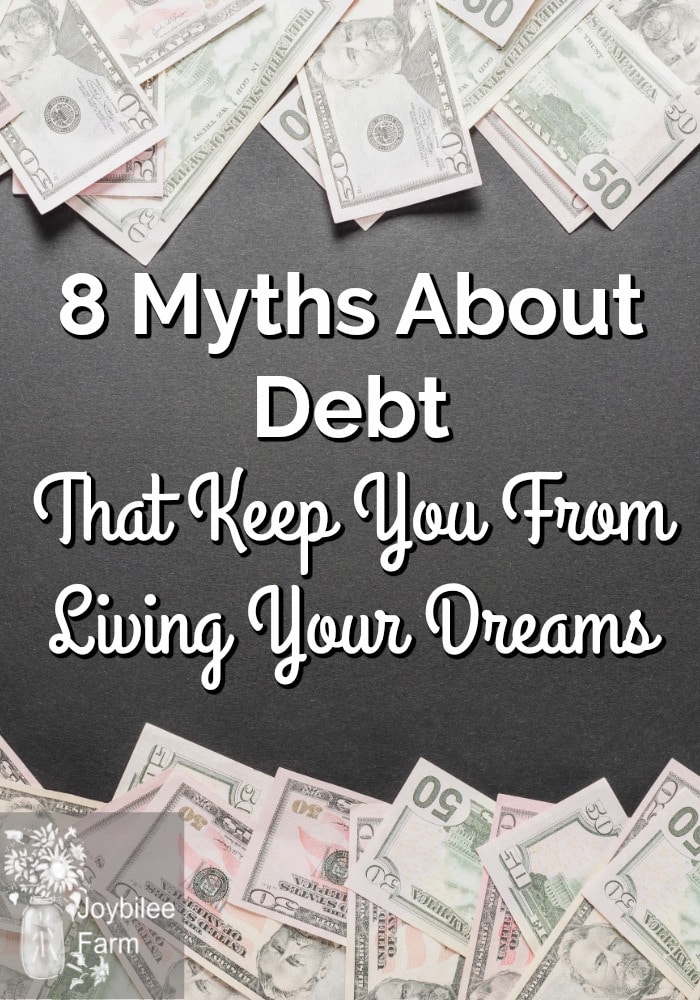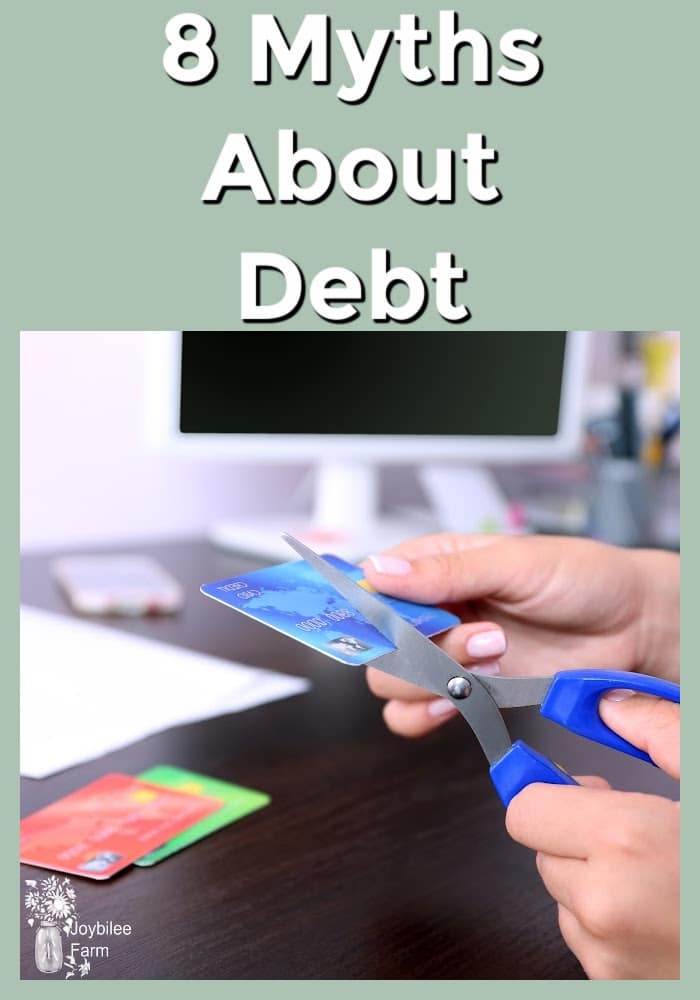8 Myths about debt that keep you from living your dreams
If you are in debt, addressing these 8 myths about debt and changing your thinking is the first step in moving toward paying off your debt and beginning to live your dreams, embracing your passion.

Debt is conformity. Debt is bondage. Debt prevents you from living your dreams and following your passion. Ben Franklin said, “When you run in debt, you give another power over your liberty.”
I did some research into the worldwide Occupy movement. Almost everyone brave enough to post their story mentioned being in debt as the main cause of their homelessness and dissatisfaction. They owned a home, lost their job, couldn’t make the payments and lost their home. Or they financed their university education with debt, are working two minimum wage jobs and can’t afford to pay rent and buy food, because of their university loans, so they’ve moved back in with Mom or Dad. Others mention the inability to find full-time employment with benefits, so they work long hours at several jobs and still can’t pay rent or buy food. For these people life is hard. Making choices between buying medicine or buying food is difficult. Parents, adult children and grandchildren living together again after many years of independence feels like failure. And the single pervasive element woven through the 99% is the ugly spectre of debt.
A recent article in Outlook, a publication of the CGA Assoc. of BC, “CGA-Canada sounds the alarm on household debt” offers some startling statistics about debt in this country:
– The average Canadian family has a debt to income ratio of 146.9%.
-If the household debt was spread evenly across the country, a hypothetical family with two children would be in debt $176, 461.
– One-third of retired households are $60,000 or more in debt. (Outlook Fall 2011, p. 58)
Sure the economy is broken. There’s an unfairness about jobs being outsourced overseas and multinational corporations being favoured by the government that supposedly represents the people. Unemployment is high. Satisfaction is low. But I argue that the central factor in the mess is our beliefs about debt.
Myths that you’ve been told about debt:
1. Debt is normal – Everybody is in debt
The system is run on debt. Our governments finance their programs through deficit budgets. When the government cuts funding to programs or imposes austerity measures to try and balance the budget, the people cry, “foul.”
Our society begins at birth to encourage parents to spend money — often money they don’t have. Your kids need vitamins, immunizations, dental visits, eye doctor visits, orthodontic visits, preschool to prepare them for school, extra shoes, extra clothes. Schools encourage families to take on debt through their “demands”. School supply lists, sports costs, music costs, school uniforms and fundraising events — all cost money, too. Add in a few extra lessons or sports teams and the costs grow.
A US government study suggests that the cost of raising a child today to high school graduation is $234,000US or 13 thousand dollars a year. Mostly financed by credit. In school, kids are turned into automatons. They learn to shut down their instincts to move, to talk, to experiment and they learn to colour inside the lines. They learn to obey without question. They learn to live within the system and to be good employees — good workers. And from 4 years old the answer to the question, “What are you going to be when you grow up?” needs to be something other than, “I’m going to be a Mommy (or Daddy).” And so at 5 years old the expectation of university education, financed through debt, is already planted in their young minds.
2. Debt is temporary
No one believes that when they first lay down plastic to buy a loaf of bread or to fill up the gas tank, that debt will be a chain around their neck that will enslave them for their lifespan. The rationale is, I’ll just use the credit card today and I’ll pay it off at the end of the month. I’m not really in debt.
Then there is an unexpected expense — $500 to buy snow tires for the car. “I don’t have a choice. Snow is in the forecast and the tires are worse than I expected. But it will be all right, I’ll pay it off at the end of the month on the line of credit. We’ll manage.” Once we accept the easy credit, the debt grows, often beyond our ability to pay it off at the end of the month.
3. Its all right to take on debt to buy something that will appreciate in value
Some of us, who normally wouldn’t go into debt for everyday expenses, rationalize indebtedness by telling ourselves that if we are buying an asset — something that will earn money in the future, or something that will increase in value — like an education or a home — debt is acceptable. That’s what keeps our economy growing.
Some of the myths that are corollaries to this are:
-If I take a loan for university it will help me get a better paying job
-Debt is leveraging what I have today to increase my net worth tomorrow.
-I’m investing in my RSP through debt so that I can save on my income taxes today.
-A mortgage isn’t really debt because my house is going to appreciate and it will make me money in the long run.
None of these myths bear the scrutiny of reality. Many university grads find themselves without a job in their chosen field, forced to work any job they can find to begin making payments on their university loans. Alternatively, to avoid the payment cycle, they go to grad school and increase their indebtedness. Unfortunately, after graduation, there still aren’t any jobs in their field and now they are overqualified. The Bachelor of Business grad who is the manager at Tim Hortons isn’t going to hire an MBA grad to work under him. And if we’re talking union jobs, management can’t afford to hire an MBA to take an entry-level position, when there’s a Mom who just put her 3-year-old in Daycare and needs to supplement the family income to pay the mortgage. Moms don’t cost as much as MBAs.
Investing in an RSP may save you money in taxes, but it won’t necessarily increase your retirement savings. We invested in RSPs for years. After 20 years of investment, often forced to invest in risky mutual funds rather than GICs because our financial advisor insisted that we had “room for risk” in our portfolios, we don’t have much more than we put in initially. We now look at our RSPs as if they are nonexistent. We can’t draw on them in need without heavy financial penalties and when we reach retirement age, they may be worthless. Pay off debt first rather than invest in RSP or retirement savings.
A mortgage is a debt. When you take on a mortgage you rely on your income increasing to pay the increased costs of your debt, as future interest rates rise. There is an assumption that owning a home is better than renting and that housing increases in value with time. But mortgages come with hidden costs. The interest cost alone means that buying a home with debt increases the actual cost of owning by almost twice the original purchase price. A $200,000 mortgage, amortized over 25 years will cost you $350,000 at 5% interest — assuming that the interest rates remained stable. But they don’t. Then there are the hidden costs. If you have a mortgage then you must have household insurance — another $800 to $2,000 per year, depending on if you are rural or city. Property Taxes will net you another $800 to $3,000 per year depending on where you live. Both of these costs are added to the monthly mortgage payment and then fees are added to pay for the privilege of having the bank collect these things on your behalf. So your $200,000 mortgage is going to cost you $1,400 per month over 25 years and you’ll pay double the principle with the hidden costs, and still have the maintenance and repairs to manage.
Am I saying never get a mortgage to finance a home purchase? No, but there are other avenues to owning property that needs to be explored as well.
4. Tomorrow will be better than today, and then I’ll get out of debt.
Or the corollary: The economy will keep growing at an exponential rate. We can borrow from future productivity to maintain the status quo now.
The global economic troubles have proven this to be false. While the multinational corporations are juggling their portfolios to buy out their failing competition, the actual productivity worldwide is pretty stable. The increase in profits is coming from an increase in prices not an increase in the units of goods sold.
Tomorrow will be what you create today — if you create debt today you will be in bondage tomorrow. If you create productivity you will have a productive tomorrow.
5. Debt is the solution to today’s problems and tomorrow will be problem-free.
This is another take on myth number 4. The solution to today’s problems is not debt but frugal living, contentment, and increased productivity. When you solve the problem by throwing money at it, you stop creative thinking and block future productivity.
6. Debt will vanish if I just make the minimum payment.
My mother was a slave to debt. Growing up in poverty in Northern Ontario, she knew what it was like to work a minimum wage job, to be emotionally destroyed when she approached welfare for help, and to be forced into prostitution, as a single mom, in her 20s to get a few dollars to pay the rent. I’m very grateful for the sacrifices that she made to raise me. But she wasn’t happy. She struggled to get her high school diploma and secretarial training. For 40 years she worked in government offices at union jobs. She maxed out her credit cards and only paid the minimum payment. Her rented apartment was filled with broken toys, cheap clothing, and throw away memories. She died in debt at 65.
Minimum payments only cover the interest charges. Paying only the minimum payment means you continue to pay for toys, long after they are broken.
7. I can afford to be in debt, but I can’t afford to pay cash.
If you are living paycheque to paycheque, you need to rethink your budget. Move to a cheaper place, decrease your utility bills, cancel your cell phone or your internet service. A few extra expenses that need to go on the credit card, won’t cripple you, but making credit a money management tool will make you a slave to debt.

8. I have to be in debt to keep my job.
A corollary to this is: “I have to look successful to keep my clients, and to do that I have to be in debt.” Many industries require image building as part of the corporate culture. Image building comes with designer clothing, expensive cars, country club memberships, and the latest technology. Robin is a Certified General Accountant. In the latest issue of Outlook, the CGA-BC magazine has an article modelling the well-dressed accountant with hefty designer price tags. Being a CGA in industry or public practice requires a huge investment in professional fees, liability insurance and style. Even financial professionals struggle with debt.
If you are already in debt, addressing these 8 myths about debt and changing your thinking is the first step in moving toward paying off your debt and beginning to live your dreams, embracing your passion. Debt is a child of the broken system. Homestead entrepreneurship is the nonconformist alternative.
If you found this article helpful please share it with your friends, link to it on Facebook, tweet about it on Twitter. Send me some link love and I’ll return the favour.
Your Turn:
What myths have you believed about debt? How has believing those things kept you from realizing your dreams and pursuing your passion? Leave a comment:
Some resources to help you on your journey to debt-free living:
The Complete Tightwad Gazette
Debt-Free Living: Eliminating Debt in a New Economy
Making Your Money Last! – 7 Steps To Debt-Free Living
How to Survive Without a Salary: Learning How to Live the Conserver Lifestyle





I got this site from my pal who shared with me on the topic of this site and at the moment this time I am visiting this site and reading very informative articles at this place.
I got this site from my friend who informed me regarding this website and now this time I am browsing this web site and reading very informative content at this place.